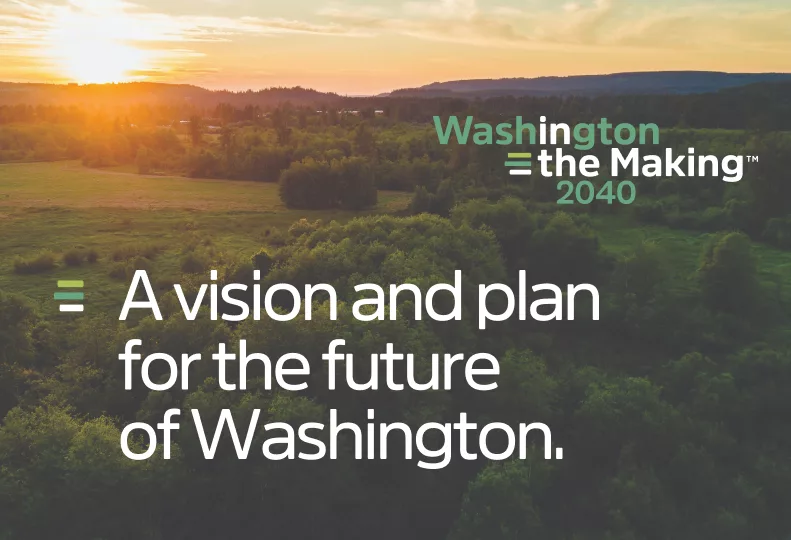A plan for opportunity and prosperity in Washington
By the Association of Washington Business Institute

Washington has a history of creativity and invention. Medical breakthroughs, aerospace and software innovations, and advancements in energy generation are just a few Washington ideas that have changed the world.
Our state has many brilliant thinkers and makers, and even more potential to grow. What we don’t have is a long-term economic plan to face the challenges of the next 15 years.
A plan for action
Washington in the Making 2040 is a vision for the state’s economic future informed by the priorities of Washingtonians from every part of the state. The goal is to drive progress toward that vision — engaging community and industry leaders, business owners, policymakers and others to take action.
“Washington’s population is set to grow by 2 million people between now and 2040. And we face big challenges — a housing shortage, rapidly growing energy demand, a growing workforce shortage and the rising cost of doing business,” said Kris Johnson, president and CEO of the Association of Washington Business Institute. “It’s time to think strategically about our economic future and to come together around our shared priorities.”
Shaped by residents’ priorities
In creating Washington in the Making 2040, business leaders at the Washington Roundtable and AWB asked thousands of Washington residents what mattered most to them.
What did their communities need? What did their businesses and industries need? What did a hopeful, healthy future look like to them?
What followed was a process of reaching people in all 39 counties of the state. Through surveys, in-person town halls, and input from experts, more than 4,200 Washington residents weighed in.
“There’s so much disagreement and uncertainty in our country right now,” said Steve Mullin, president of the Washington Roundtable. “What struck us was the extraordinary level of agreement among the thousands of people we heard from.”
The research found:
- 93% of Washingtonians thought it was important to expose teens to more career paths, including through work experience before high school graduation.
- 85% prioritized building enough affordable housing to support a growing workforce.
- 87% prioritized making sure Washington has enough clean, affordable and reliable energy.
These, and 11 other top priorities for residents, drive Washington in the Making 2040.
The plan also includes quantifiable goals and strategies for addressing these priority issues. Many communities have already developed similar goals and strategies.
Here in Spokane, for example, zoning laws have been amended to spur housing development, allowing for more mixed-income neighborhoods with room for more residents.
Easing barriers for business owners
One of the many Washington business stories that helped form this plan came from Efrain Ramirez and Fidel Negrete, who own two coffeehouses and a juice bar in Yakima and Wapato.
They now employ a dozen people, but the process of opening those businesses felt like navigating a maze. Ramirez and Negrete had a destination in mind. What they didn’t have was a map.
Licensing alone was confusing, with competing requirements from multiple entities and jurisdictions. They eventually found guidance and a loan through a rural community-development program, but it took trial and error to get there.
Many more prospective business owners don’t ever reach that point. The vision outlined in Washington in the Making improves the processes and regulations that are currently impeding business growth, or preventing new small businesses from opening.
Entrepreneurs throughout the state should have access to multilingual mentorship, information and resources that demystify the process of opening business. More great ideas would see the light of day, providing jobs and fueling strong communities.
A vision for a vibrant state
The vision is that by 2040:
- Washington will be a top spot to do business, with an environment where employers can grow and succeed — which means untangling our web of regulations, among other strategies.
- Our world-class workforce will be prepared for the jobs of tomorrow. That means helping industries offer more work-based learning opportunities.
- Our infrastructure will meet employers’ and communities’ needs in every part of the state, which means meeting the steeply rising demand for affordable, reliable energy.
- Every community will enjoy an exceptional quality of life, which means building 1 million new housing units.
“Now is the time for every community to come together, share ideas, spark conversation and start moving ideas and policies forward,” Johnson said. “It will take a lot of creativity, collaboration and commitment to meet our vision of opportunity for every person and prosperity in every region.
“If anyone can make this happen, it’s Washington.”
See the full plan, find up-to-date economic data, and sign up for email updates at WA2040.org.

_c.webp?t=1763626051)

_web.webp?t=1764835652)
